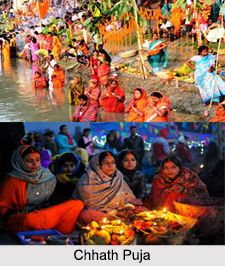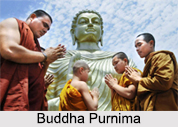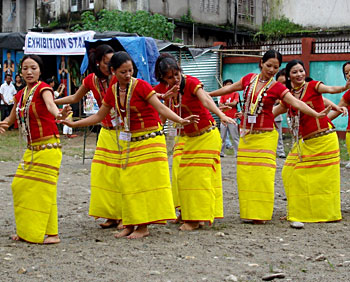 Celebrated on the sixth day of Shukla paksh of the month of Kartika in the historical Hindu calendar known as the Vikram Samvat, the festival of Chhath Puja typically falls on the months of October or November. The festival is also celebrated during summer in the month of Chaitra, few days after Holi and is known as Chaiti Chhath.
Celebrated on the sixth day of Shukla paksh of the month of Kartika in the historical Hindu calendar known as the Vikram Samvat, the festival of Chhath Puja typically falls on the months of October or November. The festival is also celebrated during summer in the month of Chaitra, few days after Holi and is known as Chaiti Chhath.
This ancient Hindu Vedic festival of Chhath is celebrated mainly in the Indian states of Bihar, Jharkhand, Odisha, Madhya Pradesh, Uttar Pradesh, Uttarakhand, Chhattisgarh and Rajasthan. Dedicated to Lord Surya and his sister Chhathi Maiya, a unique aspect of the Chhath Puja is that there is no idol worship. Observed over a period of 4 days, Chhath is an arduous observance, requiring the worshipers to fast without a sip of water for around 36 hours continuously.
Etymology of Chhath Puja
In Indo- Aryan languages like Maithili and Bhojpuri, the word chhath means sixth as the festival is celebrated on the sixth day of the month of Kartika. The Chhath Puja is known to be the longest and most important festival among the Hindus after navaratri.
History of Chhath Puja
There are mentions of Chhath Puja in the ancient Vedic texts like the Rig Veda contains hymns worshipping the Sun God and has descriptions of similar rituals to the festival. These rituals are also mentioned in one of the Sanskrit poems in Mahabharata, where Draupadi is depicted observing the similar rites.
The poem further illustrates that worshipping Lord Surya, Draupadi was not only able to solve her immediate problems, but also helped the Pandavas later regain their lost kingdom. Thus portraying that celebrating Chhath Puja and offering prayers to the Sun God brings good fortune to the people as the deity bestows bounties on life on earth.
 The festival also has mentions in the Ramayana, where it is celebrated by Lord Rama and Sita after their return to Ayodhya during the coronation of Lord Ram. After their 14 years of exile, they performed the festival with due diligence and had kept fast and offered their prayers to Lord Surya.
The festival also has mentions in the Ramayana, where it is celebrated by Lord Rama and Sita after their return to Ayodhya during the coronation of Lord Ram. After their 14 years of exile, they performed the festival with due diligence and had kept fast and offered their prayers to Lord Surya.
In the Vedas, Chhathi Maiya is known as Shashti Devi, the Hindu Goddess who is worshipped during this festival. Chhathi Maiya is another avatar of the Goddess Parvati, the sister of Lord Surya and the consort of Lord Shiva.
Rituals of Chhath Puja
Observed over a period of 4 days, the rituals of Chhath Puja are rigorous that include bathing in holy water and standing in the water for long periods of time, fasting without sipping a single drop of water, also known as Vratta and offering prayers to the rising and setting sun. Devotees are not supposed to wear stitched clothes, the men wear dhoti and the women wear cotton sarees. Discussed below are the four days of the festival:
Naha Kha (Day 1): The first day of the Chhath Puja starts exactly 4 days from the Hindu festival of Diwali. On this day, the devotees take their first bath at a river or any kind of water body and later prepare lunch comprising of rice, dal mixed with pumpkins, made in pure ghee.
Kharna (Day 2): It is a day before Chhath and the devotees fast for the whole day, which is broken late in the evening after sunset. A delicacy called kheer roti or kheer puri is prepared for dinner, which is consumed after offering it to the rising moon and the Goddess Ganga. From this point onward until the next 36 hours, the devotee goes on a fast till the last day of Chhath.
Chhath (Day 3): The main day of the Chhath festival, the day is spent preparing the prasad at home. On the eve of this festival, all the members of the family along with the devotees go to a riverbank to make the offerings or Arghya to the setting sun. It is during this phase of Chhath Puja that the devotees offer prayers to the setting sun.
Ritual rendition of regional folk songs, carried on through oral transmission from mothers and mothers-in-law to daughters and daughters-in-law, are sung on this occasion.
On the night of day 3, a colourful event of Kosi is held. Here, lighted earthen lamps are kept under a canopy of 5 sugarcane sticks. The 5 sticks signify the human body made of Panchabhuta (the 5 great elements - earth, water, fire, air and ether). This is a symbolic ritual in Chhath Puja, performed especially in those families where marriage or childbirth has taken place recently. The lighted lamps signify the solar energy sustaining the human being. People perform this ritual at home, during late evening on day 3 after making the offering to the setting sun.
Parna (Day 4): The final day or a day after the Chhath, the fourth day is known as Parna when the devotees along with family and friends, go to the riverbank before sunrise. There they worship the rising sun and the festival ends with the breaking of the fast by eating prasad offerings which include sweets like kheer and thekua, rice laddu and fruits.
The Chhath Puja is an important Hindu festival that worships both the rising and setting sun. It is known that the sun is necessary for the life of possibly every creature on the earth and this festival is a way to pay tribute to it irrespective of caste, creed, gender and social stigmas.



















